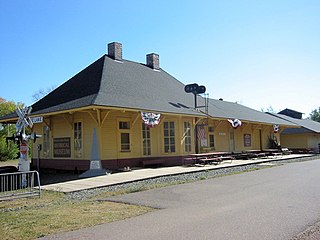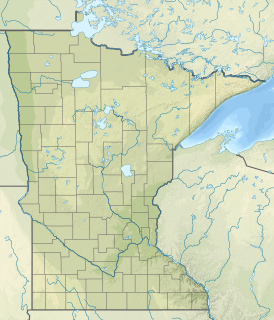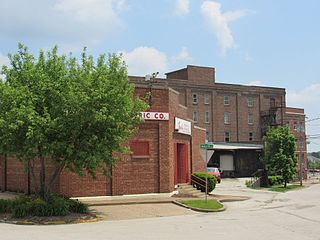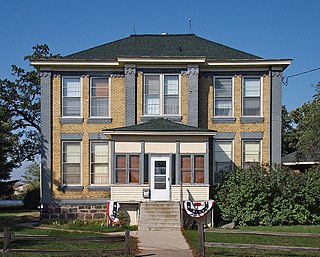PotlatchDeltic Corporation is an American diversified forest products company based in Spokane, Washington.

The Twin Ports of Duluth, Minnesota and Superior, Wisconsin, are located at the western part of Lake Superior and together are considered the largest freshwater port in the world. They are twin cities and seaports, connected to the Atlantic Ocean through the Great Lakes and the Saint Lawrence Seaway. The Twin Ports are at the core of the U.S. Census Bureau's "Duluth, MN-WI Metropolitan Statistical Area", which includes all of Wisconsin's Douglas County, and Minnesota's Carlton, Lake, and Saint Louis counties. With a 2020 census population of 291,638, the Duluth MSA ranked as the 170th largest metropolitan area in the United States. Approximately 6.7 million tourists visit Duluth alone each year, this does not account for surrounding suburbs such as Virginia, Two Harbors, Ely, or Hibbing.

Savanna Portage State Park is a state park of Minnesota, USA, established in 1961 to preserve the historic Savanna Portage, a difficult 6-mile (9.7 km) trail connecting the watersheds of the Mississippi River and Lake Superior. The portage trail crosses a drainage divide separating the West Savanna River, which drains to the Mississippi River and the Gulf of Mexico, from the East Savanna River, which flows in an opposite direction to the Saint Louis River, Lake Superior and the Great Lakes, and the Saint Lawrence River to the Atlantic Ocean.

The St. Croix Boom Site is a historic and scenic wayside on the St. Croix River in Stillwater Township, Minnesota, United States. It commemorates the location of a critical log boom where, from 1856 to 1914, timber from upriver was sorted and stored before being dispatched to sawmills downstream. The site was developed as a roadside park along Minnesota State Highway 95 in the 1930s. In 1966 it was designated a National Historic Landmark for its national significance in the theme of industry. It was nominated for being the earliest, most important, and longest serving of the log storage and handling operations that supported Minnesota's major logging industry. Virtually no traces remain of the site's original buildings and structures.

The Cloquet fire was an immense forest fire in northern Minnesota, United States in October 1918, caused by sparks on the local railroads and dry conditions. The fire left much of western Carlton County devastated, mostly affecting Moose Lake, Cloquet, and Kettle River. Cloquet was hit the hardest by the fires. It was the worst natural disaster in Minnesota history in terms of the number of casualties in a single day. In total, 453 people died and 52,000 people were injured or displaced, 38 communities were destroyed, 250,000 acres (100,000 ha) were burned, and $73 million in property damage was suffered. Thirteen million dollars in federal aid were disbursed.

The Marine Mill, established in 1839, was the first commercial sawmill in what became the U.S. state of Minnesota. Now in ruins, it is currently a historic site managed by the city of Marine on St. Croix in partnership with the Minnesota Historical Society. It was listed on the National Register of Historic Places as the Marine Mill Site in 1970 for having state-level significance in the themes of exploration/settlement, industry, and transportation. It was nominated for being the birthplace of the region's seminal industry—lumbering—and a major landing on its crucial transportation route, the St. Croix River. The site is also a contributing property to the Marine on St. Croix Historic District.

The Frederic M. Sibley Lumber Company Office Building is an office building located at 6460 Kercheval Avenue in Detroit, Michigan. It was designated a Michigan State Historic Site in 1989 and listed on the National Register of Historic Places in 1991. The building is known for being the beginning of a major trailer manufacturing company.

This is a list of the National Register of Historic Places listings in Carlton County, Minnesota. It is intended to be a complete list of the properties and districts on the National Register of Historic Places in Carlton County, Minnesota, United States. The locations of National Register properties and districts for which the latitude and longitude coordinates are included below, may be seen in an online map.

Moose Lake station in Moose Lake, Minnesota, United States, is a depot built in 1907 by the Soo Line Railroad. The building was one of the few buildings that survived the 1918 Cloquet Fire, and it was used to provide shelter for those left homeless in the fires. It was listed on the National Register of Historic Places in 1994 as the Minneapolis, St. Paul, and Sault Ste. Marie Depot.

Charles Insco Williams was an artist and architect in Dayton, Ohio.
This is a list of properties and historic districts within the Downtown St. Louis and Downtown West, St. Louis areas of the city of St. Louis, Missouri that are listed on the National Register of Historic Places. The downtown area is defined by Cole Street to the north, the river front to the east, Chouteau Avenue to the south, and Jefferson Avenue to the west. Tucker Avenue divides Downtown to the east from Downtown West to the west.
The Verdi Lumber Company Buildings are three historic buildings on Main St. in Tonopah, Nevada. The buildings include two two-story lumber sheds, one open and one enclosed, and a storage building. The buildings were constructed in 1911, the year the Verdi Lumber Company was incorporated. A branch of the Tonopah and Goldfield Railroad connected to the site, allowing the company to transport its products. The company eventually became the largest lumber company in central Nevada. The three buildings are the only remaining buildings from the company's Tonopah facilities.

Alden Lake is fresh water 180 acre lake with 159 (88%) acres of littoral area and a maximum depth of 29 feet located in northern Minnesota 14 miles northeast of Duluth off St. Louis County Highway #44. Alden does not have a developed public access along the shoreline but can be accessed by canoe through the Cloquet River. The primary fish management species is walleye, with secondary management for largemouth bass and smallmouth bass.

The Gordon–Van Tine Company Historic District, also known as the U.N. Roberts and Company Buildings, is a nationally recognized historic district located east of downtown Davenport, Iowa, United States. It was listed on the National Register of Historic Places in 2017. The Gordon–Van Tine Company manufactured pre-cut, mail-order homes in this facility, beginning around 1916.

The Virginia–Rainy Lake Lumber Company Office is a former office building in Virginia, Minnesota, United States. It was built around 1907 as the headquarters for the Virginia–Rainy Lake Lumber Company, the largest lumber company in the Upper Midwest in the early 20th century. The building was listed on the National Register of Historic Places in 1980 for its state-level significance in the theme of industry. It was nominated for representing one of the Iron Range's few major industries aside from mining.

The Virginia–Rainy Lake Lumber Company Manager's Residence is a historic house in Virginia, Minnesota, United States. It was built in 1910 to provide upscale quarters for the manager of the Virginia–Rainy Lake Lumber Company, the largest lumber company in the area. The house was listed on the National Register of Historic Places in 1980 for its local significance in the themes of industry and social history. It was nominated for reflecting the social distance enforced between industry elites and laborers in the early 20th century. The city's working class population at the time was crowded into boarding houses and small cottages, and it was common for large companies to erect lavish residences for their managerial class in the belief that telegraphing class distinctions was essential for maintaining workforce discipline.

The LeMoine Building is a historic commercial building in the unincorporated community of Gheen, Minnesota, United States. It was built in 1913. In 1989 it was listed on the National Register of Historic Places for its local significance in the theme of commerce. It was nominated for being one of northern Minnesota's few surviving examples of the once-common false-fronted commercial building and the most intact historic building in the lumber-era townsite of Gheen.

The Missouri Lumber and Mining Company (MLM) was a large timber corporation with headquarters and primary operations in southeast Missouri. The company was formed by Pennsylvania lumbermen who were eager to exploit the untapped timber resources of the Missouri Ozarks to supply lumber, primarily used in construction, to meet the demand of U.S. westward expansion. Its primary operations were centered in Grandin, a company town it built starting c. 1888. The lumber mill there grew to be the largest in the country at the turn of the century and Grandin's population peaked around 2,500 to 3,000. As the timber resources were exhausted, the company had to abandon Grandin around 1910. It continued timber harvesting in other parts of Missouri for another decade. While some of the buildings in Grandin were relocated, many of the remaining buildings were listed on the National Register of Historic Places in 1980 as part of the state's historic preservation plan which considered the MLM a significant technological and economic contributor to Missouri.

The Pine Tree Lumber Company Office Building is a historic building in Little Falls, Minnesota. It was built in 1891 as a headquarters for the Pine Tree Lumber Company, headed by Charles Weyerhaeuser and Richard Musser. The building was added to the National Register of Historic Places on September 5, 1985.

















